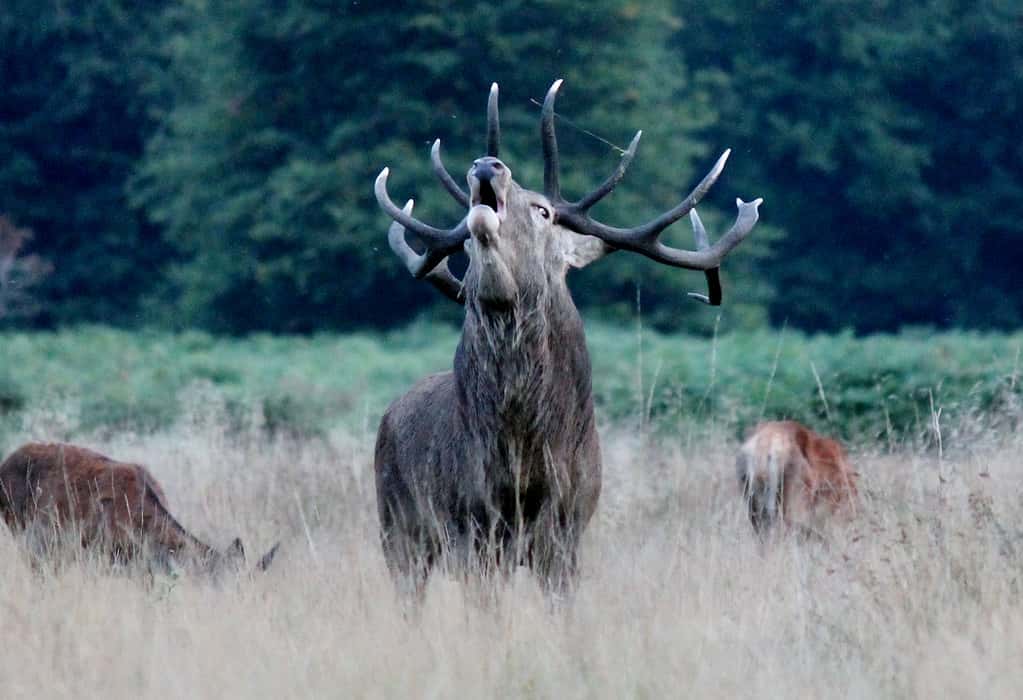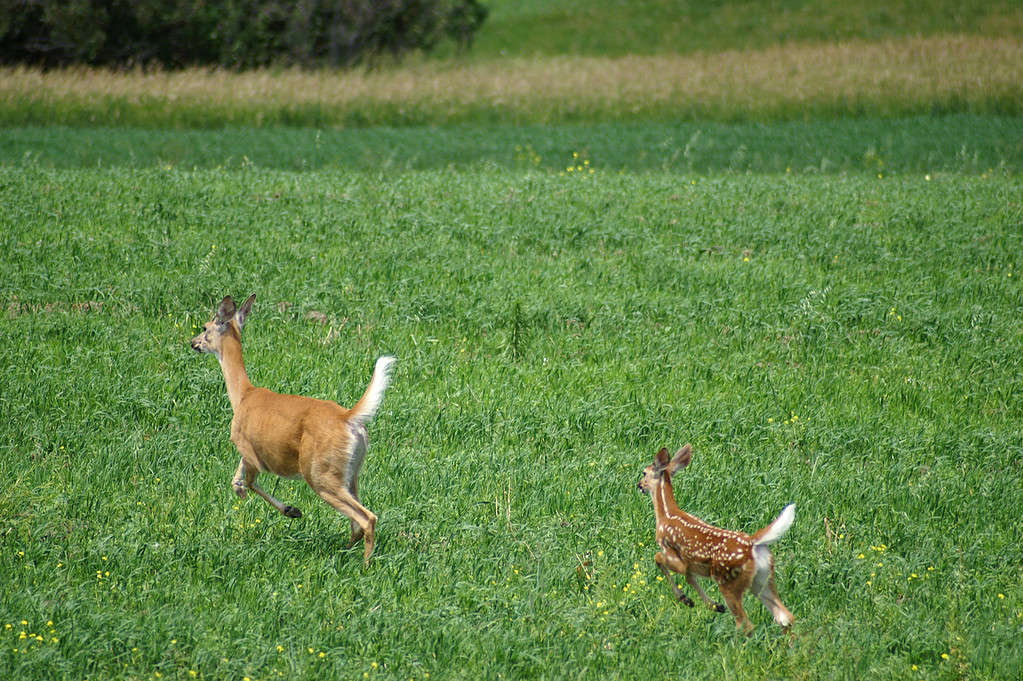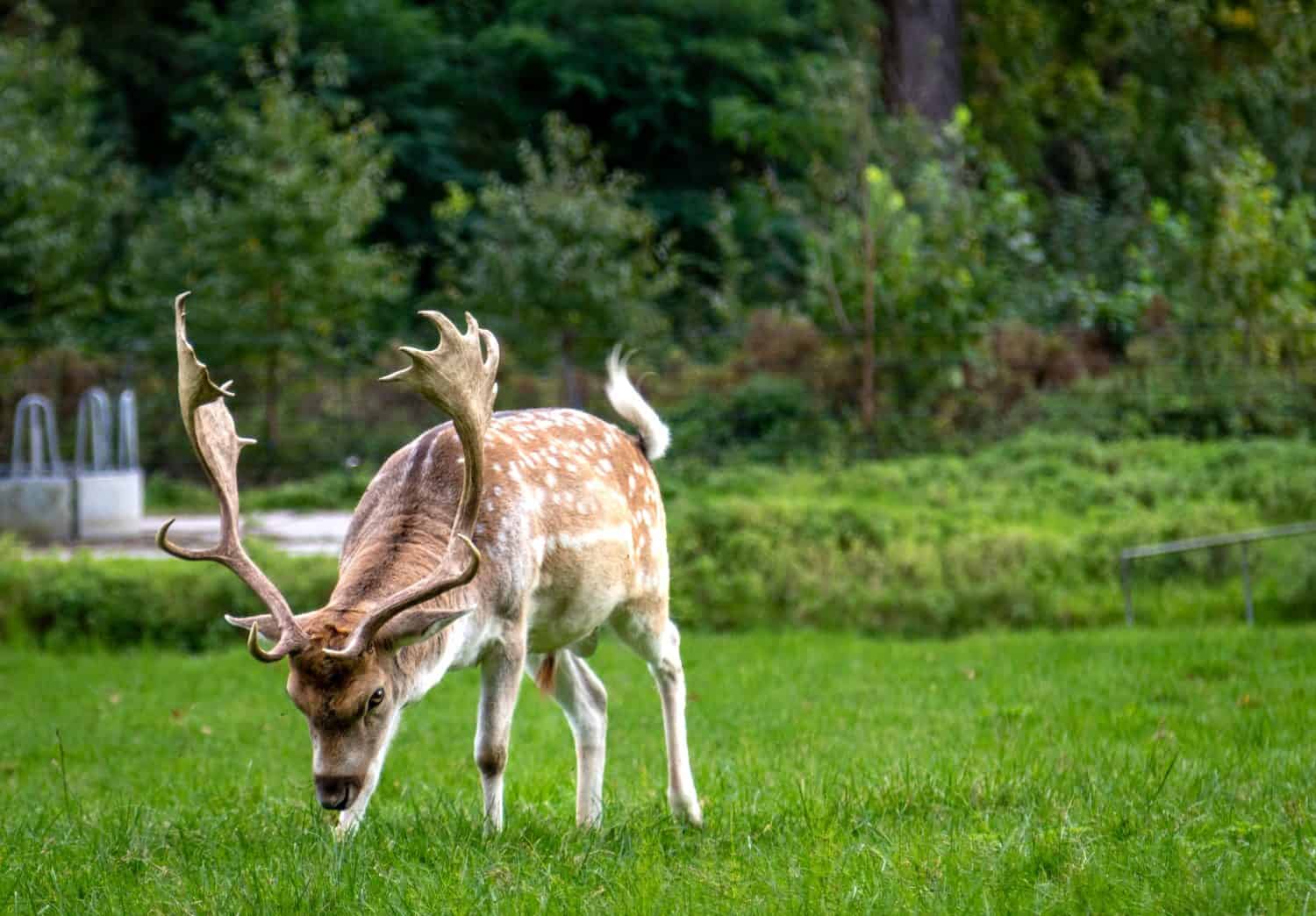Graceful, swift, social, and vigilant, deer rely on their agile and fast movements, attention to their environment, and effective intraspecific communication to survive. Deer primarily use vocalizations, body language, and chemical signaling to communicate.
In this guide, we’ll delve into how deer communicate with each other and what they’re signaling. Read on to learn more!
How Do Deer Communicate: Vocalizations
While deer are generally not perceived by most humans as notably vocal animals, they do produce a range of sounds to communicate with each other regularly. Grunts, bawls, bleats, snorts, wheezes, bellows, and dry barks are all a part of the deer’s vocal repertoire.

Deer use a range of vocalizations to communicate with each other.
©cheekylorns/iStock via Getty Images
Non-Aggressive Vocalizations
Grunts are one of the most common sounds used in non-aggressive communication between deer. One of the first sounds a fawn hears is the grunt of their mother as she first communicates with them. This sound encourages her baby to approach and signals feeding time. Bucks also use grunts year-round to call one another and locate family members. Bucks also produce grunts, known as tending grunts, during mating season.
Bawls, bleats, and bellows are additional vocalizations deer use to communicate with one another. Does and fawns frequently bleat to communicate with each other and the larger herd. These vocalizations can help in locating one another and providing social reassurance. The bleats of fawns, especially in the first four months of life, are quite high-pitched and whine-like sounds. Finally, deer can alert each other to danger by snorting and blowing, in which the deer forcibly and repeatedly exhales through their nostrils. This sound signals to other deer that danger is imminent. Typically, the herd will bolt at this point.

Fawns will be quick to call their mothers.
©PatrikStedrak/iStock via Getty Images
Confrontational Vocalizations
Deer can produce a range of sounds during ritualized displays of aggression. These sounds are generally meant to intimidate other deer and prevent injury-causing conflict. Harsh, rapid snorts and wheezing are the most common vocalizations used during agonistic displays between deer. Bucks will also use these sounds in an attempt to scare off competitors.
How Do Deer Communicate: Body Language
Through body positioning, deer can communicate a range of emotions and intentions to each other. Warning signals, intraspecific threat displays, relaxation, fearfulness, and vigilance can all be communicated by deer with body language.
Warning Signals, Fearfulness, and Vigilance
A deer with tense body language, uplifted, and their head and nose held high can signal possible danger to other deer in the area. On a whitetail deer (Odocoileus virginianus), the hair around the tail and rump will flare when the deer is nervous and alert. This signal can alert other deer to be vigilant without outright sending an alarm to flee.
Ears and eyes directed toward a sound can indicate to other deer where the potential threat may be coming from. To communicate potential danger to other deer, an individual may stomp their feet, throw their nose in the air, and waive their tail. Finally, outright bolting is a clear signal to flee an area. When fleeing, whitetail deer often position their tail upright and flag them side to side. This visual signal helps keep a group of deer together as they run from danger.

Whitetail deer use their tail to signal possible and identified danger to members of their herd.
©Mike Coddington/iStock via Getty Images
Aggressive Body Language and Threat Displays
A head held flat or lowered, horizontally dropped ears, staring, a stiff and heavy walk, hair standing upright, and antlers positioned toward a threat or competitor are all signs of aggression. This posturing most frequently occurs between rival bucks and between deer of both sexes when food is scarce. Before a physical confrontation, two bucks may also display sidling in which they stand roughly 30-degree angles from each other, often slowly circling one another. Sometimes, the posturing and sidling are enough to make a less confident, younger, or smaller buck back down.

Aggressive displays are most frequent in bucks during mating season.
©JW.photography31/Shutterstock.com
How Do Deer Communicate: Relaxed Body Language
A relaxed deer features loose, rather than stiff, body positioning, a slightly drooped head, relaxed ears, and a casual, side-to-side tail wag. This positioning signals to the rest of the herd that danger is not detected. At this time, deer will likely graze or browse while periodically scanning for potential threats.
How Do Deer Communicate: Chemical Signaling
Deer can communicate with each other very effectively through the use of chemical signaling. Deers can communicate reproductive status and health and assert territorial boundaries by spreading their pheromones strategically throughout their environment. Researchers believe that bucks may also communicate age and social status through chemical signaling. Deer can also communicate possible danger by snorting and spreading alarm pheromones into the air.
The photo featured at the top of this post is © Christopher Roth/iStock via Getty Images
Thank you for reading! Have some feedback for us? Contact the AZ Animals editorial team.







